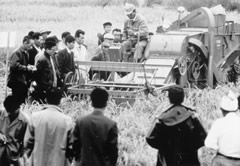Rural Society and Technology
Increasing agricultural production, especially the output of rice, was a target that the Tokugawa government pursued throughout the period of its rule, from 1600 to 1868. Under this policy flood-control works and irrigation facilities were constructed, making possible the reclamation of large areas of paddy land. The supply of irrigation water, however, often lagged behind the rapid expansion of the area under paddy rice, and this often caused water disputes between upstream and downstream villages. To mediate disputes, water users’ associations were established with villages as their constituent units and, through the mediation of such associations, water-control customs were gradually established among villages.
It should be noted that the associations were considered self-reliant because the Shogunate and the fief governments left the villages free to regulate water use locally. Within a village, water-control practices were institutionalized as customary regulations that had to be observed by every village inhabitant. In this way Japanese rural society became a “water-bound society,” characterized by water-control systems.
After the Meiji Restoration of 1868, policies to increase staple production and to raise agricultural productivity were pursued by the central government, with particular reference to the reformation of the landholding system and increased investment in irrigation systems and land improvement projects. The traditional self-reliant water-control system that had evolved in pre-Meiji rural society survived by adapting to the government’s modernization policy.
Since the 1960s, however, over-production of rice and the pressure from abroad to liberalize farm product imports have brought about many changes in Japanese farming in modern times. The effect of this new situation on traditional irrigation practices remains an open question.


